eISSN: 2093-8462 http://jesk.or.kr
Open Access, Peer-reviewed

eISSN: 2093-8462 http://jesk.or.kr
Open Access, Peer-reviewed
Young Sub Shin
, Jae Soo Hong
, Young Moon Kim
, Woo Joung Sim
, Jong Hyun Kim
10.5143/JESK.2022.41.2.77 Epub 2022 April 29
Abstract
Objective: The aim of this study is to propose a safety design guideline for a tricycle tandem for two persons for the elderly and persons with disability through standard survey and dynamics simulation.
Background: In this recent, the issue of leisure and quality of life for the elderly has become more important due to the aging population. It has been found that the elderly and persons with disability prefer to ride a tricycle outdoors as a leisure activity to enjoy with family and friends. Most of the tricycles they can enjoy together are imported products and have not been developed in consideration of the domestic use environment, so research on their safety is needed.
Method: In this study, in order to propose a safety design guideline for a tricycle tandem for two persons, the Korean standard (KS) was investigated to derive, and 10 major safety design factors were derived from the four related standards. And the importance of safety design factors was analyzed using the AHP (Analytic Hierarchy Process) method. In addition to the dynamics simulation of steering, safety design guidelines for 10 major safety design factors have been proposed.
Results: In the results of the importance analysis (AHP) between the 10 safety design factors derived through the survey of existing standards, 'braking performance (importance 0.223)' was identified as the most important design factor. And secondly, 'steering angle and stability (importance 0.137)'. In the result of the dynamics simulation for steering angle and stability factor, the risk of overturning increased as the driving speed and steering angle increased, and overturning occurred when turning to 12 deg while driving at a speed of 20km/h.
Conclusion: In this study, 10 major safety design factors related to a tricycle tandem for two persons were derived from the existing standards, and design guidelines (checklists) were defined by them. In addition, among the high-priority factors, the dynamics simulation was performed on the 'steering angle and stability' that requires specific design guidelines, and the conditions under which overturn occur were confirmed.
Application: It is expected to secure safety, develop multi-seater bikes, and develop assistive devices for leisure activities in localization of a tricycle tandem for a two persons for the elderly and persons with disability.
Keywords
Safety standard Tricycle tandem for two persons for the elderly and persons with disability Safety design guideline Analytic hierarchy process Steering dynamics
한국의 65세 이상 고령 인구는 16.6%(2021년)이며, 2030년에는 25.5%로 증가할 것으로 예상된다(KOSIS, 2021). 65세 이상 장기요양급여 수급자 중 독립보행이 불가능한 고령자는 78.7%로 나타났다(KOSIS, 2019). 따라서 고령자들의 독립적인 일상생활을 위하여, 기립과 보행을 지원하는 이승, 이동기기 개발 연구들은 활발하게 수행되었다(Kim et al., 2020; Song et al., 2013). 고령자와 장애인의 보다 높은 차원의 삶의 질 향상을 위한 보조기기 개발은 일상생활 지원보다는 여가생활을 지원하고, 사회참여를 유도하여, 지속적으로 사회와 연계된 삶을 영위하는 방향으로 기술 개발 트렌드가 변화하고 있다.
여가활동으로 인해 인지 기능 장애와 치매에 대한 완화 효과를 가지며, 시간적 여유가 많은 고령자의 무료함을 해소할 수 있고, 고령자가 가질 수 있는 사회적 고립을 완화할 수 있다(Hwang, 2014; Chung and Kim, 2021). 신체적 능력이 저하된 고령자와 장애인이 여가생활을 영위하기 위해서는 많은 제약이 따르므로, 관련 보조기기 개발을 통해 고령자와 장애인에게 신체적, 정서적, 사회적으로 긍정적인 영향을 미칠 수 있는 여가활동을 지원해야 한다(Lee et al., 2020; Lee, 2016).
Shin and Lee (2008)의 연구 결과에 따르면, 조사대상자(예비고령자) 398명 중 95%가 '여가활동이 중요하다'라고 생각하며, 선호하는 여가활동으로는 산책, 등산과 같은 외부활동들로 나타났다. 조사에 응한 예비고령자들은 대부분 가족이나 지인과 함께 여가활동을 즐기고 싶어 하는 것으로 나타났고, 혼자 여가활동을 하겠다는 응답은 1% 미만으로 나타났다.
따라서 본 연구에서는 고령자와 장애인이 실외에서 가족이나 지인과 함께 즐길 수 있는 보조기기로 자전거를 선정하였고, 이에 대한 안전성 연구를 통해 안전 설계 가이드라인을 제안하였다.
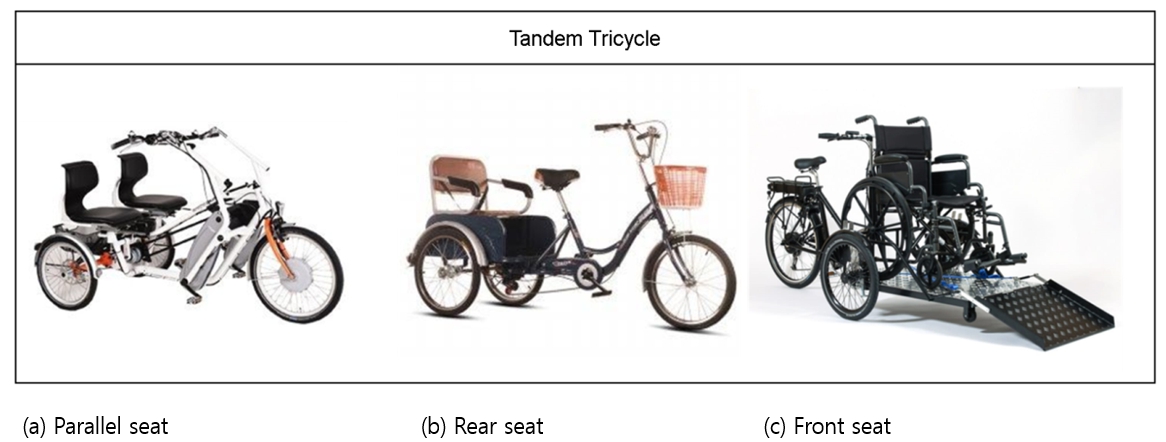
고령자와 장애인이 가족이나 지인과 함께 즐길 수 있는 실외용 다인승 자전거는 크게 '병렬 탑승 방식'과 '직렬 탑승 방식', 두 가지로 구분되며, 직렬 탑승 방식은 탑승자 위치에 따라 고령자나 장애인이 뒷좌석에 위치하는 방식과 역 삼륜으로 고령자나 장애인을 앞 좌석에 위치하는 방식으로 구분할 수 있다(Figure 1). 첫 번째 병렬 탑승 방식은 서로 나란히 앉아, 자전거를 구동하기 때문에, 함께 즐기는 재미가 크고, 동승자의 상태를 파악하기 수월한 장점이 있지만, 자전거의 너비가 넓어 조향 시 회전 반경이 증가함에 따라 일반 자전거 도로에서 주행에서는 문제점이 있다(Figure 1(a)). 두 번째로 고령자나 장애인이 뒷좌석에 탑승하는 직렬 탑승 방식은 운전자가 고령자나 장애인의 상태를 파악하기 어려우며, 고령자와 장애인의 탑승 만족도가 낮다(Figure 1(b)). 세 번째로 고령자나 장애인이 앞 좌석에 위치하여, 주변 경관을 즐기며, 가족이나 지인과 함께 즐길 수 있는 방식의 직렬 탑승 방식은 앞의 두 가지 자전거 타입의 단점을 보완할 수 있다(Figure 1(c)). 본 연구에서는 세 번째 타입인 직렬 탑승 방식에서 고령자나 장애인 앞에 위치하는 2인승 역 삼륜 자전거를 대상으로 안전성 연구를 수행하였다.
본 연구의 안전성 연구 대상 제품인 2인승 역 삼륜 자전거는 국내 개발 제품이 없어, 관련 규격이나 연구가 전무하고, 또한 레저활동을 지원하는 제품에 대한 규격이나 지침, 정책에 관한 연구도 미흡한 편이다(Kim et al., 2021). 본 연구의 연구 대상 제품은 주요 사용자가 고령자와 장애인으로 개발과정에서 안전성이 더욱 중요하게 고려되어야 하는 제품이다. 따라서 4가지 KS 규격을 조사하고, 관련 안전 설계 요소들을 기반으로 2인승 역 삼륜 자전거의 안전 설계 가이드라인을 제안하였다.
안전 설계 요소들 중 구체적인 수치가 필요한 요소들에 대해서는 규격 조사만으로 가이드라인의 구체성을 확보하기 어려워, 구동 시뮬레이션을 수행하여, 근거 기반의 설계 가이드라인을 제안하였다.
2.1 The concept of a tricycle tandem for two persons for the elderly and persons with disability
2인승 역 삼륜 자전거의 구조는 고령자나 장애인이 탑승하는 부분(Front part)과 보호자가 탑승하는 부분(Back part) 이렇게 크게 2가지 부분으로 구분된다. 후면 탑승 부분은 보호자가 구동(수동(페달링), 전동), 조향에 대한 조작을 가능하게 하는 조향부(Steering part)와 구동부(Driving part)로 구성되어있다. 전면 탑승부는 휠체어의 탑승을 돕기 위하여, 지면까지 경사로로 연결되는 출입부(Entrance part)와 휠체어 탑승 장치를 통해 안전하게 고정하고, 탑승자의 안전에 관한 부분인 고정부(Fixed part: Wheelchair tie-down and occupant-resistant systems (WTORS))로 구성되어있다. 자전거의 구동은 크게 수동식과 전동모터에 의해 전동식으로 구동된다. 보호자의 발 페달링과 고령자나 장애인의 핸드 페달링에 의한 수동식, 그리고 후륜에 연결된 모터에 의한 전동식으로 구동된다(Figure 2).
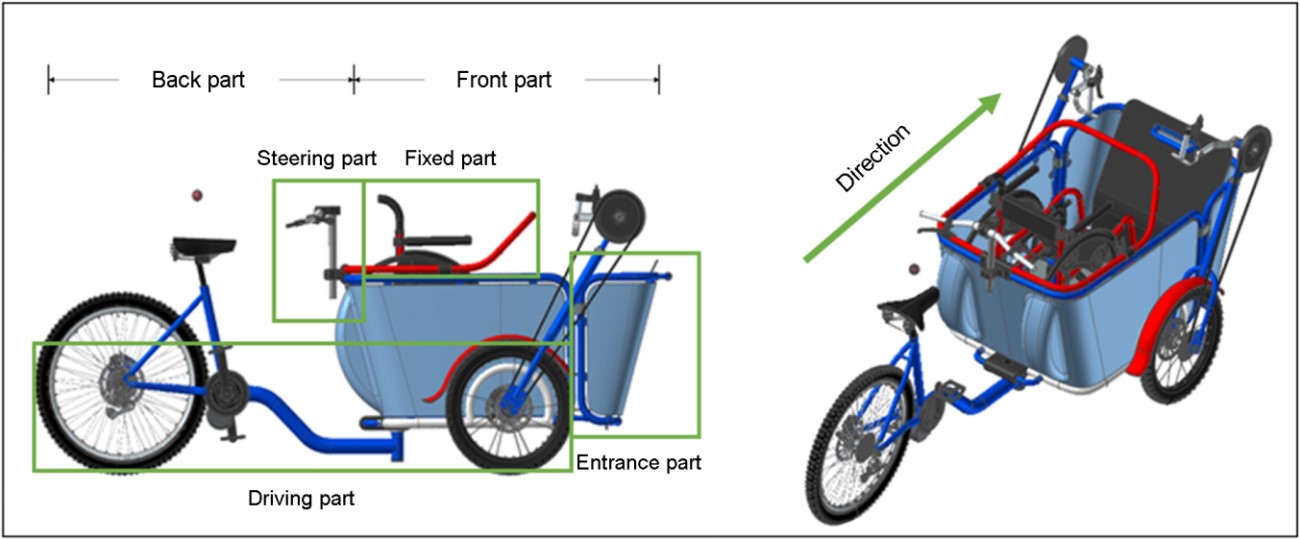
2.2 Definition of safety design factors using standard survey
국내에는 고령자와 장애인(휠체어 탑승)을 위한 2인승 역 삼륜 자전거의 안전 설계 요소에 규격이 없어, KS 규격 검색(KSCI)을 통해 대상 자전거의 설계 요소들을 갖추고 ㅊ규격 4가지를 다음과 같이 선정하였다.
① KS R 1092: 2013 일반용 자전거 안전성(Safety requirements of bicycles for general use) (KATS, 2013).
② KS R ISO 4210-2: 2014 2륜 자전거 안전 요구사항(Cycles-Safety requirements for bicycles)_제2부 도시 및 트레킹용, 청소년용, 산악용 자전거 요구사항(KATS, 2014).
③ KS G ISO 20957-5: 2016 고정식 운동기구(Stationary training equipment)_제5부 자전거 에르고미터 및 상체 크랭크 운동기구(KATS, 2016).
④ KS P ISO 105421-1: 2012 장애인용 기술적 장치 및 보조기구-휠체어 고정구 및 탑승자 구속 장치(Technical systems and aids for disabled or handicapped persons-Wheelchair tie-down and occupant-resistant systems)_제1부 모든 장치에 대한 요구사항 및 시험 방법(KATS, 2012).
첫 번째 규격인 ① 'KS R 1092: 2013_일반용 자전거 안전성'에서는 제동성능(braking performance), 조향(steering), 핸들(handle), 바퀴(wheel), 체인(chain), 안장(Sadness), 보호 장치(protective device), 조명등(light), 반사경(reflector), 경음기(horn), 자물쇠(lock), 실용성능(practical performance), 페달(pedal)에 대한 안전 설계 요소들이 도출되었다. 두 번째 규격인 ② 'KS R ISO 4210-2: 2014_2륜 자전거 안전 요구사항'에서는 날카로운 모서리(sharp edges), 나사 잠금(screw lock), 브레이크(brake), 제동성능(braking performance), 핸들바(Handle bar), 최소 조향각(minimum steering angle), 조향 안정성(steering safety), 흙받이(wheel fenders), 비 고정 페달(non-fixed pedal), 고정 페달(fixed pedal), 제조자 설명서(manufacturer's instructions)에 대한 안전 설계 요소들이 도출되었다. 세 번째 규격인 ③ 'KS G ISO 20957-5: 2016_고정식 운동기구'에서는 보호 덮개(protective cover), 핸들과 페달(Handle, Pedal), 안장 높이 조절(height adjustable saddle), 크랭크(crank)에 대한 안전 설계 요소들이 도출되었다. 네 번째 규격인 ④ 'KS P ISO 105421-1: 201_장애인용 기술적 장치 및 보조기구'에서는 별도의 휠체어 고정 장치(separate wheelchair fixture), 휠체어의 브레이크 의존성(wheelchair's dependence on brakes), 스트랩 및 앵커포인트의 조절로 인한 다양한 휠체어의 적용(adjustable straps and anchor points for various wheelchair applications), 공구 없 이 사용(adjustable without tools), 탑승자 구속 장치(equipped with occupant restraint (belt))에 대한 안전 설계 요소들이 도출되었다.
|
Standards number & title |
Safety factors |
Major safety factors |
|
① KS R 1092: 2013 Safety requirements of |
Braking performance |
a)
Braking performance b)
Steering angle and stability c) Apply the
ergonomic size of the handle and saddle d) Drive
system protective cover e) Light safety standards |
|
Steering |
||
|
Handle |
||
|
Wheel |
||
|
Chain |
||
|
Sadness |
||
|
Protective device |
||
|
Back (light) |
||
|
Reflector |
||
|
Horn |
||
|
Loc |
||
|
Practical performance |
||
|
Pedals |
||
|
② KS R ISO 4210-2: 2014 Cycles - Safety requirements |
Sharp edges |
a) Braking performance b) Steering angle and stability c) Apply the ergonomic
size of the handle and saddle d) Drive system protective cover e) Light safety
standards |
|
Screw lock |
||
|
Brake |
||
|
Braking performance |
||
|
Handle bar |
||
|
Minimum steering angle |
||
|
Steering safety |
||
|
Wheel fenders |
||
|
Non-fixed pedal |
||
|
Fixed pedal |
||
|
Manufacturer's instructions |
||
|
③ KS G ISO 20957-5: 2016 Stationary training equipment |
Protective cover |
|
|
Handle, Pedal |
||
|
Height adjustable saddle |
||
|
Crank |
||
|
④ KS P ISO 105421-1: 2012 Technical systems and aids |
A separate wheelchair fixture. |
f) A separate wheelchair fixture. |
|
Wheelchair's dependence on brakes. |
g) Wheelchair's dependence on brakes. |
|
|
Various wheelchairs can be applied through strap and anchor point
adjustment. |
h) Various wheelchairs
can be applied through strap and anchor point adjustment. |
|
|
Use without tools |
i) Use without tools |
|
|
Equipped with occupant restraint (belt) |
j) Equipped with occupant restraint
(belt) |
이렇게 4가지 규격에서 총 32가지 안전 설계 요소들을 도출하였고, 중복되거나 관련이 적은 설계 요소들을 제외하여 10가지 주요 안전 설계 요소를 도출하였다(Table 1).
2.3 Priority analysis of safety design factors
기존 규격 조사 분석을 통해 도출된 10가지 안전 설계 요소들 간의 우선순위(중요도)를 분석하기 위하여, AHP (Analytic Hierarchy Process) 기법을 활용하였다. 안전 설계 요소들 간의 우선순위 분석은 개발자가 제품의 안전성을 확보하는 것에 있어, 설계 요소 간의 이해가 상충되는 문제가 있을 때, 우선 설계 요소(체크리스트)를 고려할 수 있게 하고자 함이다.
AHP 기법은 Thomas Saaty에 의해 제안된 다기준 의사결정 분석에 해당하는 분석 방법의 하나로 다수의 평가 요소들을 계층화하여 각 요소의 가중치에 따라 최적의 대안을 선정하는 방법이다(Kim et al., 2021). 본 연구에서는 10가지 안전 설계 요소들을 9점 척도로 이루어진 설문지로 1대1 쌍대 비교를 통해 우선순위를 결정하였다. AHP 평가 결과의 일관성 지수(Consistency index, C.I) 0.1 이하인 경우에 분석에 활용하였다(Kim et al., 2021).
설문 대상자는 국내 사용 환경에 대한 높은 이해도를 가지고 있는 관련 전문가 4명(레저 바이크 개발자, 휠체어 관련 분야 연구자, 고령자 · 장애인 보조기기 사용성 평가 전문가, 복지용구 관련 인간공학 전문가)을 대상으로 10가지 안전 설계 요소들에 대한 중요도 평가를 수행하였다. 10가지 항목에 대한 쌍대 비교는 총 45번 진행되었으며, 평가 대상자들에게 예시 설문지와 평가 방법에 대하여 충분히 설명하였다(Figure 3). AHP 기법을 활용한 중요도 결과 분석은 Expertchoice (Decision Science, Korea) 소프트웨어를 통해 수행되었으며, 획득된 데이터 중 C.I 지수가 0.1 이상이거나, 평가 항목에 대한 점수가 누락된 경우는 제외하였다. 10가지 주요 안전 설계 요소 간 중요도에 대한 유의성을 확인하기 위해 일원 배치 분산분석과 사후 검정(Tukey)을 수행하였다(SPSS (IBM, USA), p < 0.05).
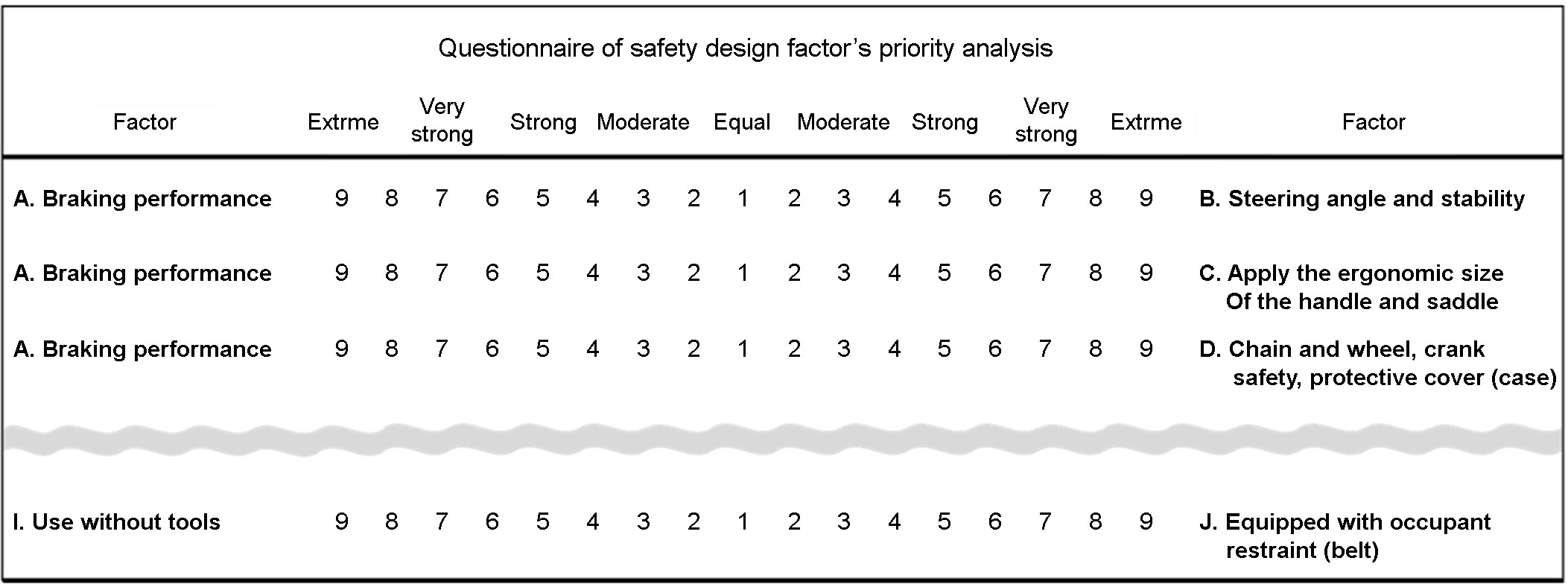
2.4 Dynamics Simulation of steering safety
10가지 안전 설계 요소 중 '제동성능'과 '조향 각도 및 안정성'은 구체적이고, 정량적인 데이터 기반의 설계 가이드라인이 필요하다. 제동성능은 관련 규격들을 참고하여, 제한 속도 및 제동 거리에 대한 안전 설계 요소가 제시할 수 있으나, '조향 각도 및 안정성'에 대한 항목은 개발하고자 하는 제품과 규격 대상 제품이 상이하여, 규격을 참고한 가이드라인 제안이 어려웠다.
따라서, 규격 조사 및 문헌 조사를 통해 구체적인 가이드라인 제시가 어려운 '조향 각도 및 안정성'에 대한 동역학 시뮬레이션을 수행하였고, 시뮬레이션은 리커다인(RecurDyn, FuctionBay, Korea) 소프트웨어를 사용하였다.
물적 요소들은 실제 시제품 제작에 활용한 재질을 참고하여 설정하였으며, 타이어의 재질은 고무(JSR BUTYL 365, 밀도: 9.19975 × 10(-7) kg/mm3)를 적용하였고, 타이어를 제외한 2인승 역 삼륜 자전거의 모든 재질은 알루미늄(AL6061-T6, 밀도: 2.7 × 10(-7) kg/mm3) 재질을 적용하여 해석을 수행하였다. 탑승자를 제외한 2인승 역 삼륜 자전거의 전체 무게는 위의 재질을 적용한 약 45kg으로 설정하였다. 탑승자 및 운전자의 무게 중심 위치는 바이크 안장으로부터 20cm 위에 위치한 지점으로 정의하였다.
|
Conditions |
Independent variable |
Dependent variable |
|
Steering angle |
10°, 12° |
The ground reaction force
of both front wheels |
|
Driving speed |
10, 20km/h |
선회 조건은 가속을 시작한 시점으로부터 20초가 지난 시점에 0.5초간 좌측으로 설정된 조향 각도(10°와 12°)를 변경하는 것으로 설정하였다. 조향 시 주행 속도는 10km/h와 20km/h로 설정하였고, back part 보호자의 무게는 80kg, front part 탑승자(고령자 또는 장애인)는 휠체어 포함 150kg으로 설정하였다(Table 2).
3.1 Result of safety design factors' priority analysis
2인승 역 삼륜 자전거의 10가지 안전 설계 요소들 간의 중요도를 분석한 결과에서는 A(제동성능)이 중요도 0.233으로 가장 우선순위가 높은 안전 설계 요소로 중요도로 나타났다. 다음으로는 B(조향 각도 및 안정성)는 0.137, C(인간공학적 치수 적용)는 0.132, D(구동계 보호 덮개)는 0.090, E(조명 안전 규격)는 0.028, F(별도의 휠체어 고정 장치)는 0.055, G(휠체어의 브레이크 의존성)는 0.086, H(스트랩 및 앵커포인트의 조절로 인한 다양한 휠체어의 적용)는 0.035, I(공구없이 사용)는 0.026, J(탑승자 구속 장치)는 0.132의 우선순위 순으로 나타났다. 중요도 분석의 일관성 지수 C.I. (Consistency index 0.038)로 평균오류 횟수는 0회로 나타났다. 중요도 결과 값에 대한 분산분석 결과 유의수준 0.05 이내(p = 0.02)에서 유의하게 나타났다. 사후 검정(post hoc test)에서는 A-E (p = 0.031), A-H (p = 0.042), A-I (p = 0.028) 간의 유의성이 나타났다(Figure 4).
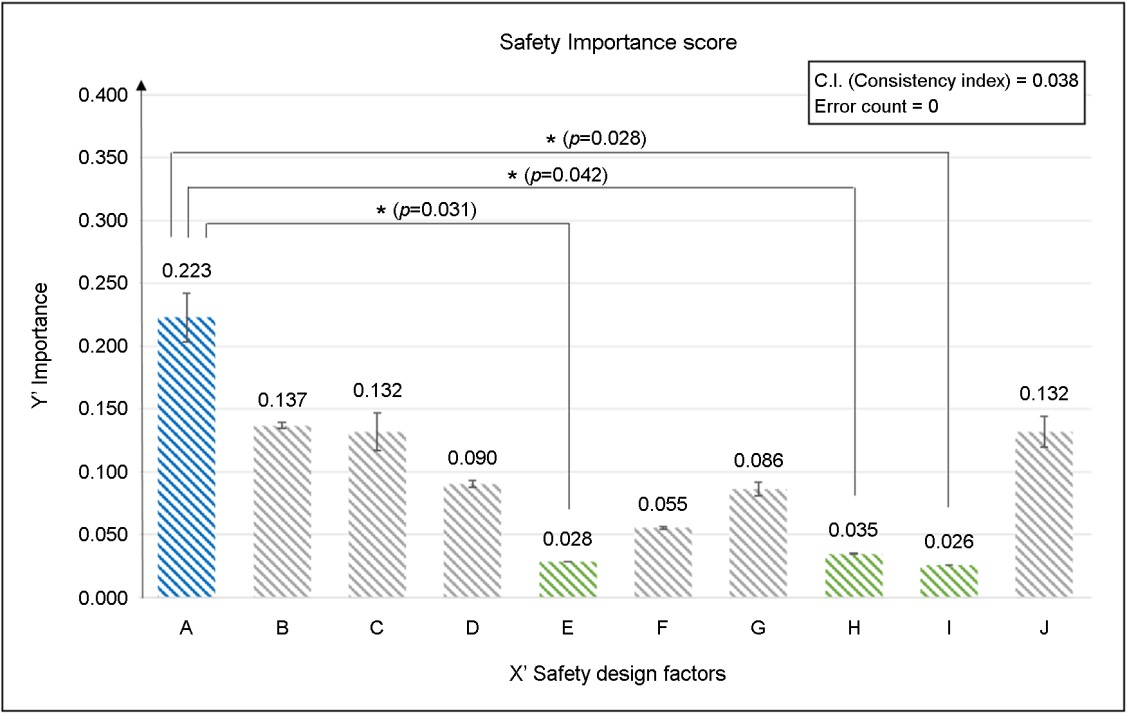
3.2 Result of dynamics simulation for steering safety
'조향 각도 및 안정성'에 대해 2가지 독립변수(속도, 조향 각도)를 적용한 동역학 시뮬레이션 결과를 도출하였다(Figure 5). 주행 중 양쪽 전륜의 지면 반발력은 모두 1008.4N으로 나타났고 10km/h의 속도로 주행 중 조향 각도를 10° 변경하여 선회할 경우에는 좌측 전륜의 지면 반발력은 748.9N, 우측 전륜은 1254.4N으로 나타났고(Figure 5(a)), 20km/h의 속도로 주행 중 조향 각도를 10°로 변경할 경우 좌측 전륜의 지면 반발력은 173.3N, 우측 전륜은 1816.3N으로 나타났다(Figure 5(b)). 20km/h의 속도로 주행 중 조향 각도를 12°로 변경하여 선회할 경우에는 조향을 시작한 지점으로부터 약 0.5초가 지난 후에 우측 전륜의 지면 반발력이 2배 정도로 증가하고, 회전하는 방향으로 전복이 발생하였다(Figure 5(c)), (Table 3).
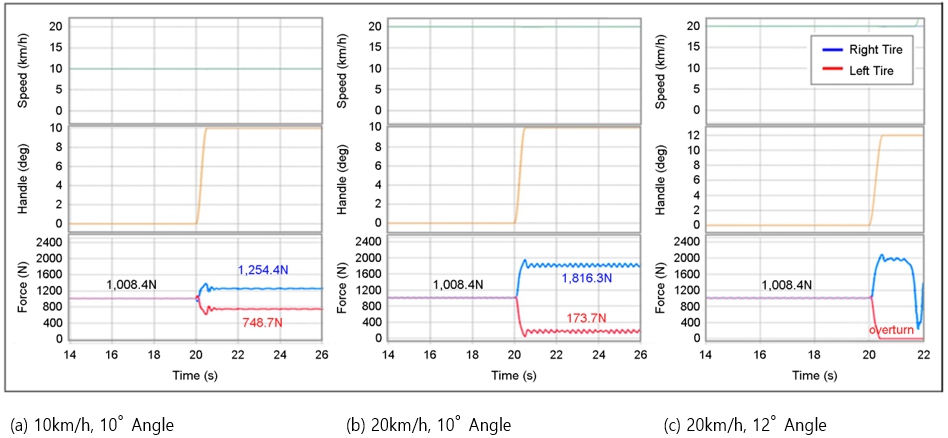
|
Conditions |
Factor |
Left Tire |
Right Tire |
|
Speed : 10km/h Angle : 10 deg |
Driving |
1008.4N |
|
|
Turning |
748.9N |
1254.4N |
|
|
Increase rate |
-25.7% |
24.4% |
|
|
Speed : 20km/h Angle : 10 deg |
Driving |
1008.4N |
|
|
Turning |
173.7N |
1816.3N |
|
|
Increase rate |
-82.7% |
80.1% |
|
|
Speed : 20km/h Angle : 12 deg |
Driving |
1008.4N |
|
|
Turning |
0N |
2016.8N |
|
|
Increase rate |
-100% |
100% |
|
3.3 Guidelines for 10 safety factors of a tricycle tandem for two persons
기존 규격 4가지와 우선순위 분석 결과, 조향 각도에 대한 해석 결과를 참고하여 10가지 안전 설계 요소에 대한 가이드라인을 도출하였다. 필요한 부분은 추가적인 문헌 조사를 통해, 10가지 안전성 요소들에 대한 가이드라인(체크리스트)을 다음과 같이 제안하였다(Table 4).
A. 제동성능은 24km/h(기어비 5m 이상) 주행 시 5.5m 이내에서 정지, 16km/h(기어비 5m 미만) 주행 시 5.5m 이내에서 정지, 16km/h (빗길) 주행 시 10m 이내 정지해야 한다.
B. 10° 이상의 조향 각도에서는 속도를 16km/h 이하, 그리고 10~15°에서의 조향 각도에서는 속도를 10km/h 이하로 주행한다.
C. 인간공학적 치수 적용은 다양한 연령대와 신체 조건을 가진 사람들이 이용할 수 있어야 하며 핸들 바의 전체 너비는 600mm 이하, 핸들의 최대 높이와 안장의 최저 높이 간의 차이는 400mm 이하로 설계해야 한다(Kim et al., 2021; Jang et al., 2018).
D. 구동계 보호 덮개는 크랭크가 회전 중 보호 덮개를 벗어날 때 크랭크와 보호 덮개 사이의 거리가 10mm 이상이어야 한다(Sferopoulos, 2016).
E. 조명 안전 규격은 후미 반사경은 반드시 있어야 하며 자전거의 진행 방향과 평행해야 한다(Kim et al., 2020; Jun et al., 2012).
F. 별도의 휠체어 고정 장치는 탑승자와는 별개로 휠체어를 고정시키는 장치가 있어야 한다.
G. 휠체어의 브레이크 의존성은 휠체어 브레이크와 관계 없이 휠체어가 고정이 되어야 한다(Jun et al., 2012).
H. 스트랩 및 앵커포인트의 조절로 인한 다양한 휠체어의 적용은 스트랩 길이의 조절, 앵커포인트의 앞뒤 조절로 다양한 종류의 휠체어를 부착할 수 있어야 한다(Kim et al., 2020).
I. 공구없이 사용 가능은 길이조절 구속 등에 대해서 사용자에 적합한 안장 높이(340~450mm)를 조절할 때 공구 없이 사용 가능해야 한다(Kim et al., 2021; Kim and Song, 2013).
J. 탑승자 구속 장치는 골반벨트, 상체벨트와 같이 사용자를 위한 탑승자 구속 장치 구비가 필요하다(Hong, 2012).
|
Safety factors |
Priority |
Guildelines |
|
A. Braking performance |
1 |
- 24km/h (gear ratio ≥ 5m), brake within 5.5m - 16km/h (gear ratio < 5m) brake within 5.5m - 16km/h (rainy road), brake within 10m |
|
B. Steering angle and stability |
2 |
- Over 20km/h, Steering angle below 10° - Below 20km/h, Steering angle below 12° |
|
C. Apply
the ergonomic size of the |
3 |
- It
should be available to people of various ages and physical conditions. - The
total width of the handle bar shall be 600mm or less, and the difference
between the maximum height of the handle and the lowest height of the saddle
shall be 400mm or less. |
|
D. Drive system protective cover |
5 |
- If the
crank is out of the protective cover during rotation, the distance between
the crank and the protective cover shall be not less than 10mm. |
|
E. Light safety standards |
9 |
- A rear
reflector must be present and must be parallel to the direction of the
bicycle. |
|
F. Extra wheelchair fixture |
7 |
- Apart
from the occupant, there should be a device that secures the wheelchair. |
|
G. Wheelchair's dependence
on brakes |
6 |
- Wheelchair must be fixed
regardless of wheelchair brake. |
|
H.
Apply various wheelchairs by |
8 |
- Various
types of wheelchairs should be attached by adjusting the length of the strap assembly
and adjusting the front and rear of the anchor pointer. |
|
I. Use without tools |
10 |
- When
adjusting the saddle height suitable for the user, it should be available
without tools (Adjustment of length, restraint, etc.). |
|
J. Equipped with occupant restraint (belt) |
4 |
- It is
necessary to have a passenger restraint system for wheelchair users (Hip
belt, upper belt, etc.). |
본 연구는 2인승 역 삼륜 자전거의 안전성 확보를 위해 대상 제품과 관련성이 높은 기존 4가지 규격에서 10가지 안전 설계 요소를 도출하였다. 그리고 AHP 기법을 활용하여, 안전 설계 요소들 간의 우선순위를 결정하였고, 규격 조사만으로는 구체적 설계 가이드라인 제안이 어려웠던 '조향 각도 및 안정성'에 대한 항목에 관해서는 동역학 해석을 수행하여, 안전 주행이 가능한 속도와 조향 각도 제안하고자 하였다.
10가지 안전 설계 요소들 간의 중요도를 분석한 우선순위 결과는 제동성능이 가장 높은 중요도를 나타냈고, 조향 각도 및 안전성, 인간공학적 치수 적용, 탑승자 구속 장치, 구동계 보호 덮개, 휠체어의 브레이크 의존성, 별도의 휠체어 고정 장치, 스트랩 및 앵커포인트의 조절로 인한 다양한 휠체어의 적용, 조명 안전 규격, 공구 없이 사용의 순서로 우선순위가 나타났다.
10가지 안전 항목 중 규격 조사 내용만으로는 구체적인 가이드라인 제안이 어려웠던 '조향 각도 및 안정성'에 대해서는 동역학 해석 결과 20km/h 이상의 속도로 주행하며, 12°로 선회할 시 전복이 발생하는 것을 확인하였고, 10°로 선회할 때에도 한쪽으로 80% 이상의 무게 중심이 증가하는 결과를 나타냈다. 해석 결과는 노면 상태와 타이어의 상태가 일반적인 상태로 수행된 결과이고, 원심력에 의한 탑승자와 운전자의 무게 중심이 이동하는 현상을 고려하지 않았기 때문에, 실제 주행에서는 훨씬 더 보수적으로 가이드라인을 제안하였다. 안전율 20%를 적용하여, 10° 이상의 조향 각도에서는 속도를 16km/h 이하, 그리고 10~15°에서의 조향 각도에서는 속도를 10km/h 이하로 주행하는 것을 제안하였다
본 연구는 고령자 및 장애인을 위한 2인승 역 삼륜 자전거의 안전성를 확보하기 위하여, 관련 규격 조사와 설계 요소들에 대한 우선순위, 동역학 해석을 수행하였다. 고령자와 장애인이 즐길 수 있는 여가활동의 한계를 극복하기 위한 보조기기의 하나로 2인승 자전거를 선정하였고, 가족과 함께 안전하게, 즐길 수 있는 자전거를 개발하기 위한 노력으로 본 연구가 수행되었다. 기존의 관련 제품들은 해외 고가의 수입 제품들로 안전성과 국내 사용 환경으로 인한 사용상의 한계가 있었다.
국내 사용 환경에 적합하고, 안전한 2인승 자전거, 고령자, 장애인, 그 가족들이 함께 즐길 수 있는 보조기기를 개발하여, 안전하게 여가활동을 즐길 수 있게 하는 것을 목표로 수행된 본 연구는 주요 10가지 안전 설계 요소인 제동, 조향, 탑승자 안전벨트, 안전사고 방지, 인체 치수의 적용 등에 대한 안전성 가이드라인(체크리스트)를 제안하였다. 본 연구의 개발 결과는 대상 제품인 2인승 역 삼륜 자전거의 개발에 활용되는 것뿐만 아니라 규격이 없는 국내 여가활동 보조기기 개발에서 안전성 가이드라인을 수립하는 하나의 체계적인 연구로써 활용 가치가 기대된다.
References
1. Chung, Y.M. and Kim, Y.S., The Effect of Leisure Life of Early Older People on the Satisfaction of Life by Mediating Social Relation, Studies on Life and Culture, 59, 1-21, 2021.
2. Hong, S.J., Suggestions on Traffic Safety for Mobility of the Handicapped, The Korean Society of Automotive Engineers, 34(7), 3, 2012.
3. Hwang, N.H., The Categorization of Leisure Activities for Older People in Korea, Health and Social Welfare Review, 34(2), 37-69, 2014.
4. Jang, W.H., Yang, S.W., Choi, W.S. and Kim, J.B., Development of the Hand-bike and Verification the Exercise Protocolfor People with Spinal Cord Injury, Korea Science & Art Forum, 36, 313-321, 2018.
5. Jun, S.C., Seo, J.H., Lim, H.C., Lee, C.H., Shin, Y.I. and Jung, D.Y., A study on the improvement of standards for the powered scooter and the electric wheelchair, Journal of Rehabilitation Welfare Engineering & Assistive Technology, 2012(4), 116-118, 2012.
6. KATS, KS G ISO 20957-5, Stationary training equipment, 2016.
7. KATS, KS P ISO 105421-1, Technical systems and aids for disabled or handicapped persons, 2012.
8. KATS, KS R 1092, Safety requirements of bicycles for general use, 2013.
9. KATS, KS R ISO 4210-2, Cycles-Safety requirements for bicycles, 2014.
10. Kim, J.H., Hong, J.S., Lee, H.K., Sim, W.J. and Jung, D.Y., Development of Hand-Bike Design Guideline for Elderly and Disabled Person, The HCI Society of Korea, 682-684, 2021.
11. Kim, M.S., Choi, S.A., Kim, M.K., Lee, M.S. and Bae, S.H., A Study on Smart-X Development Priority Using AHP Analysis, Innovation Studies, 16(4), 267-292, 2021.
12. Kim, S.E. and Song, B.S., A Study on the Standards of South Korea Type Manual Wheelchair in Accordance with the Human Body Size of Adult, Journal of Rehabilitation Engineering And Assistive Technology Society of Korea, 7(2), 63-68, 2013.
Google Scholar
13. Kim, Y.P., Ham, H.J., Hong, S.H. and Ko, S.C., Design and Manufacture of Improved Obstacle-Overcoming type Indoor Moving and Lifting Electric Wheelchair, Journal of Korea Academia-Industrial Cooperation Society, 21(11), 851-860, 2020. https://doi.org/ 10.5762/KAIS.2020.21.11.851
Google Scholar
14. KOSIS. Estimating the future population. Statistics Korea. 2021. [cited 2021 December 9]. Available from: http://kostat.go.kr/portal/ korea/index.action
15. KOSIS. Long-term Care Survey: (Consignee) Walking and mobility ability. Statstics Korea. 2019. [cited 2020 May 20]. Available from: http://kostat.go.kr/portal/korea/index.action
16. Lee, H.G., Kim, K.Y. and Sim, J.S., The effects of the baby boomer generation's leisure activities on depression and successful aging, Korean Hospitality and Tourism Academe, 29(4), 165-175, 2020.
17. Lee, H.G., The Effects of Depression and Psychological Wellbeing on Leisure Activities in Midlife, Northeast Asia Tourism Research, 12(2), 129-148, 2016.
18. Sferopoulos, N.K., Soft Tissue Injuries Due to Bicycle Parts in Children, ARC Journal of Research in Sports Medicine, 1(1), 15-19, 2016.
Google Scholar
19. Shin, H.K. and Lee, J.M., A study on the Change of Need about Leisure of Middle-Aged for Planning Elderly Leisure, Natural Science Research, 19(0), 1-17, 2008.
20. Song, C.Y., Yoon, H.J. and Lee, C.B., Development of Standing and Gait Assistive Wheelchair, Journal of the Korean Society of Manufacturing Technology Engineers, 22(3), 587-592, 2013. http://dx/doi.org/10.7735/ksmte.2013.22.3.587
Google Scholar
PIDS App ServiceClick here!